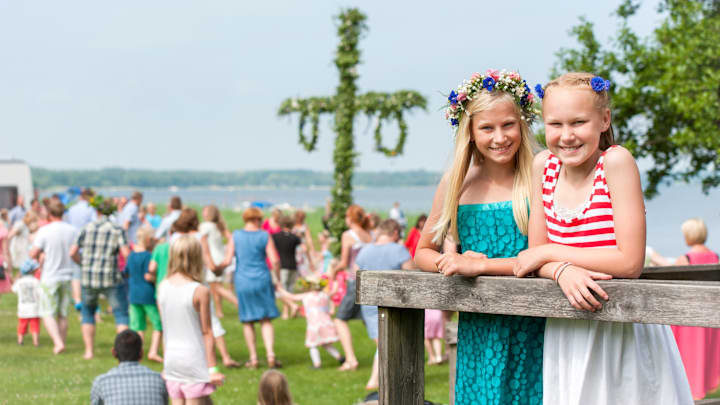If you’ve seen 2019’s Midsommer, you probably associate the holiday with flower crowns, maypoles, and a dash of human sacrifice. In reality, it’s a much more celebratory—and less deadly—affair. Midsummer is a pre-Christian tradition centered around the longest day of the year. The Celts, Vikings, and numerous other ancient peoples across Europe celebrated light reigning over darkness, as well as fertility and the blooming of summer, with bonfires, feasts, and dancing. These lively gatherings continue to take place in several countries, either on or around the longest day of the year (June 20 in 2024). The festivities vary in date and length between each country; here are 10 to know.
- Summer Solstice // United Kingdom
- Midsommar // Sweden
- Sankthansaften // Denmark
- Sankthans // Norway
- Juhannus // Finland
- Jónsmessa // Iceland
- Kresna Noč // Slovenia
- Jaanipäev // Estonia
- Hogueras de San Juan // Spain
- Enyovden // Bulgaria
Summer Solstice // United Kingdom
Neo-pagans, Wiccans, and those who have an interest in ancient customs celebrate the start of summer with a visit to Stonehenge. This year, people will be granted entry to the stones on the night of June 19 to await the sunrise on the 20. The solstice is a rare chance to get close to the mysterious monoliths, which are typically surrounded by a protective barrier.
Midsommar // Sweden
Midsummer’s Eve (Midsommarafton in Swedish) and Midsummer’s Day are celebrated on the Friday and Saturday that fall anywhere between June 19 and 25. It’s a national holiday: The Friday night is the main event, where young and old alike don flower wreaths on their heads and dance around the maypole (midsommarstangen) like frogs. There’s also a lot of drinking—and drinking songs—involved, and the libations tend to be extra strong.
Sankthansaften // Denmark
Danes honor Midsummer’s Eve, known locally as Sankthansaften (Saint John’s Eve), on June 23 every year. In medieval times, the Christian church adopted the time of Midsummer as the date to celebrate the birth of John the Baptist in an effort to rein in Europe’s existing pagan traditions. It’s no longer an official public holiday, but people still gather around bonfires to celebrate.
Sankthans // Norway
Norwegians celebrate Midsummer much like the Danes. Family and friends gather on the evening of June 23, often lighting bonfires along the water. As in Denmark, the occasion is not an official public holiday. Sankthans is more of a casual gathering than a rowdy, raucous party.
Juhannus // Finland
Finns celebrate Midsummer’s Day on the Saturday between June 20 and 26. It’s one of the highlights of the summer, and is marked by an official public holiday where people celebrate beneath the midnight sun. The Juhannuskokko (a huge bonfire) is lit the evening before and burns through the night, traditionally to keep the demons and spirits away. And of course, in true Finnish style, there’s a Midsummer sauna: the Juhannussauna.
Jónsmessa // Iceland

Icelanders celebrate their own Midsummer’s night festivities, known locally as Jónsmessa, or Saint John’s Mass, on June 24. Though the holiday is named after a Christian occasion, it features a fair share of older customs: According to Icelandic folklore, it’s a time when cows gain the ability to speak and seals can become human.
Kresna Noč // Slovenia
For centuries, Slovenians lit bonfires on June 24 to celebrate Midsummer’s Night, or Kresna Noč. According to old lore, it was a night when people were able to understand animals. The ritual was named for Kresnik, an old Slavic god of fire. In the 20th century, Kresna Noč was moved to May 1 as part of the country’s Labor Day celebrations.
Jaanipäev // Estonia
As with other European countries, the Christian church influenced Estonia’s overtly pagan Midsummer sun worshiping. Jaanipäev (Saint John’s Day) takes place on June 24 every year, around the same time that, due to its position in the northern hemisphere, Estonia experiences its “white nights.” It never gets fully dark, and many Estonians don’t sleep a great deal during the white nights, preferring to sit by their bonfires under the twilight sky.
Hogueras de San Juan // Spain
Midsummer is celebrated in Spain, particularly in the northern and formerly Gaelic areas such as Galicia, Asturias, Cantabria, and the Basque Country. In those areas, it’s easy to see the similarities between the rituals there and in the UK and Scandinavia; Hogueras de San Juan (or Bonfires of St. John) is yet another blazing Midsummer celebration.
Enyovden // Bulgaria
Bulgaria’s incarnation of Midsummer’s Day is known as Enyovden. The brave perform a barefoot dance called Nestinarstvo over embers from a bonfire. In the past, women would head out before sunrise to pick medicinal herbs, as it was believed the plants were most powerful on this day. Enyovden is celebrated on June 24, the same day the Eastern Orthodox church celebrates the day of Saint John the Baptist.
Read About More Festivals and Cultural Celebrations:
A version of this story originally ran in 2022; it has been updated for 2024.
